Architecture of Kosovo
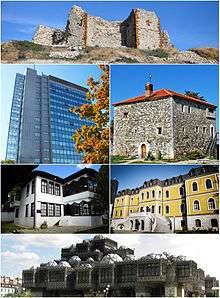
Top: Novoberdo Fortress
Centre up-left: Kosovo Parliament Building
Centre up-right: Traditional Tower in Decan
Center down-left: Ethnological Museum in Prishtina
Center Down-right: National Museum of Kosovo
Bottom: National Library of Kosovo
The architecture of Kosovo dates back to the Neolithic Period and includes the Copper, Bronze and Iron Ages, Roman Antiquity and the medieval period. It has been influenced by the presence of different civilizations and religions as evidenced by the structures which have survived to this day. Local builders have combined building techniques of conquering empires with the materials at hand and the existing conditions to develop their own varieties of dwellings.[1][2]
The monasteries and churches from the 14th century represent the Byzantine Orthodox legacy. Architectural heritage from the Ottoman Period includes mosques and hamams from the 15th, 16th and 17th centuries. Other historical architectural structures of interest include kullas from the 18th and 19th centuries as well as a number of bridges, urban centers and fortresses. While some vernacular buildings are not considered important in their own right, taken together they are of considerable interest. During the 1999 conflict in Kosovo, many buildings that represent this heritage were destroyed or damaged.[2][3] In the Dukagjini region, at least 500 kullas were attacked, and most of them destroyed or otherwise damaged.[1]
During the 1990s and thereafter, thousands of illegal buildings have been built in Kosovo. Rexhep Luci, the urban planner of Pristina who started an initiative to face this problem was killed in September 2000.[4]
Roman period
Ulpiana was a settlement of religious and cultural importance in the Roman Empire that was active in from the 1st to 7th centuries. Destroyed in an earthquake in 518, the settlement was later rebuilt by the Emperor Justinian I. Ulpiana had a sustainable urban scheme typical of a Roman city in terms of street layout and water supply. It also had 3 meter thick city walls with watch towers and 5 meter wide castle gates.[5]
Apart from Ulpiana, another notable city from the Roman Period is the Municipium Dardanorum. Among the remaining sites from this city are the Forum (Roman), the Basilica, the temple and other buildings.[6]
A monument dedicated to the Dardanian Empress is a site with notable architectural features from this era.[7]
Byzantine period

Buildings from the Late Antiquity and Early Middle Ages, when Kosovo was under the reign of the Byzantine Empire include castles in Prizren, Veletin and Kasterc, and Christian basilicas in Ulpiana, Vërmicë and Harilaq. These and other building signify cultural and spiritual developments in this area. In the Middle Ages there was a simultaneous presence of Byzantine, Catholic and Serb Orthodox Monuments.[7]
Monastery in Deçan
The church of the monastery was built by a Franciscan Friar from Kotor called Vita (Vitus). The building is of the Romanesque and Gothic architectural styles. The style it was built in is influenced by Western tradition while the main dome of the church links it with Byzantine traditions. The external part of the church contains details made of marble of different colors decorated with sculpture, while the interior part contains Byzantine frescoes. Most of the original marble furniture is still in the church which is uncommon for churches of this period from the Balkans. The church was founded by the Serbian king Serbian King Stefan Uroš III Deçanski (1321–31) and it was constructed as his mausoleum.[3]
Ottoman period
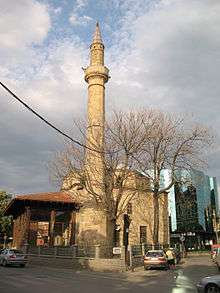
Jashar Pasha Mosque
Jashar Pasha Mosque is 16th-century mosque located in the historical center of Prishtina and it is one of the oldest buildings in Prishtina. The mosque has a prayer hall, a porch and a minaret and it is covered with a cupola. It is an architectural monument of Kosovan style with oriental influences.[2]
The Fortress of Prizren
The Fortress of Prizren is located in the city of Prizren. The first mention of it is from the 6th century AD and the last time it was used for non-recreational purposes was in 1912. The fortress has seen a number of civilizations and constructions in the castle have happened in different historical periods. The remains of the fortress are of point of interest from an architectural point of view. Although it is an important historical monument, archaeological excavations haven't been completed.[2]
20th century
Developments in the communist era
In 1950, the early days of the communist regime in Kosovo, which was then part of Yugoslavia, the motto of the state as far as city planning was concerned was "Destroy the old, build the new".[8] A 1959 book by the Municipal National Council of Prishtina called "Prishtina" shows the intentions of the regime at the time to lose the city's previous characteristics in the quest to give it more modern traits. The book boasts about 2200 newly built apartments, a number of health facilities, administrative buildings and schools, 130.000 square meters of new roads and pavements. According to this book, the new look of Prishtina was to be built on the ruins of the old city. New memorials were being erected and special care was being given to set new aesthetic foundations on the city.[9]
Hotel Union Building

The Hotel Union building is located in the center of Pristina. It is a three storey, L-shaped building of Austro-Hungarian architectural style with a surface of 500 square meters on the ground. It was designed by an Austrian architect and built in 1927 when it was used as a hotel. Because it is a distinguished example of that particular architectural style in Kosovo it was declared a protected cultural monument 1996.On August 22, 2009 the building caught on fire and sustained major damages.[2][10]
The building and the surrounding area went through a restoration Arassociati studio that made it functional again. Now it is operated by The United Colors of Benetton and is called Benetton Megastore in Pristina. The store was opened on September 9, 2013. The roof has remained its original form while the entrance has been given a new urban layout.[11]
Palace of Youth and Sport

The Palace of Youth and Sport, commonly called Boro-Ramizi, is a building from Kosovo's Yugoslavian past. It was built in 1977 with a surface of 8,136 square metres (87,580 sq ft) and was intended to be used for social, public, cultural and sport activities. The building caught fire in February 2000 due to an electrical malfunction. Now only the shopping center part of the building is functional.[12][13]
Christ the Saviour Cathedral

Construction of the Cathedral began 1995 and although it was meant to be finished in 1999, construction was halted by the Kosovo War.[14]
There are different groupings that either support the demolition, the completion or the conversion of the building to a museum. Some Albanians support its demolition or conversion, the reason being that it was built for political and not religious reasons but there are others that support its completion. According to Albanian Architect Eduard Morina who supports demolishing the Cathedral or repurposing it, the Cathedral "... doesn’t have any architectural values and is not among [listed] cultural heritage objects since it is not an old building" he continues.
Archimandrite Sava Janjic, of the Visoki Decani monastery, on the other hand, strongly support making it functional. According to him, the Cathedral is of architectural significance and "... it is a very interesting mixture of traditional and modern architecture, that shows that one must respect tradition, but also look into the future."[15]
After the war in Kosovo, the Cathedral was bombed and structural damage was caused to it In the aftermath of the war the church was bombed by unknown attackers and put under the protection of NATO peacekeepers for some years.[16]
21st century

Cathedral of Blessed Mother Teresa in Pristina
The initiators of the project for building the Roman Catholic Cathedral in Pristina are Ibrahim Rugova and Mark Sopi, who set the cornerstone for the building on June 26, 2005. Construction began on September 5, 2007 and it was formally opened by president Fatmir Sejdiu on September 5, 2000.[17][18]
Its architectural style belongs to the neo-renaissance Italian style from the 16th century and it was designed by the Architectural Association of Rome. The Cathedral has a 70 meter high tower.[17][19]
Vernacular architecture
Kulla
The type of building called kulla is a fortified residential building built in Kosovo, mainly in the Dukagjini region. The Albanian word kulla means "tower" in English. This is a type of building that was initially built from wood and stone and eventually only from stone. This type of building is typical for the Kosovan School of National Albanian Building and they have been built exclusively by the Albanian population in Kosovo. They are also the only buildings in Kosovo that haven't been influenced by foreign styles.
Kullas are heavily fortified buildings with small windows and shooting holes, because their main purpose was to offer security in a fighting situation. The first kullas that were built are from the 17th century, a time when there was continuous fighting in the Dukagjini region, although most of the ones that still remain are from the 18th or 19th century. They are almost always built within a complex of buildings with various functions but kullas in towns exist mostly as standalone structures. They are also positioned within the complex of buildings that they exist in a way that makes it possible for the inhabitants to survey the surrounding area. Kullas in towns are usually built as standalone structures, while in villages they are more commonly found as a part of a larger ensemble of kullas and stone houses, usually grouped based on the family clan they belonged to.
Most kullas are three-storey buildings. A characteristic unit of its architectural structure in "Oda e burrave" (Chamber of Men or Gathering Room of Men) which was usually placed in the second floor of the Kulla, called Divanhane, while the ground floor served as a barn for cattle and the first floor was where the family quarters were located. The material from which the Divanhane is constructed, either wood or stone, is sometimes used to classify Kullas.[1][20]
-

Kulla e Zahir Pajazitit
-

Kulla e Tahir Mehës, Prekaz
-
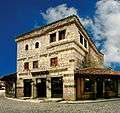
Kulla e Koshit, Gjakovë
-

Kulla e Osdautajve, Isniq
-

Kulla, Leshan
-
Kulla, Gjakovë
Peja

The architecture of Peja, Kosovo, describes a large mixture of architectural structures which are a reflection of the influential foreign rule all across the city. The architecture of the city consists of buildings, structures and constructions which were built with an architectural influence of the Byzantine architecture, Serbo-Byzantine architecture, Ottoman architecture, Stalinist architecture (former Yugoslavia), and Modern cultures/architectures. Because of this there are many churches, mosques, buildings which are attraction points in the city and were built by the aforementioned influences. The foreign rule of the Ottoman and Serbian empires and the historical influence of former Yugoslavia (communist era) have shaped the architectural landscape of the city to become a conglomerate of cultures.
Gallery of buildings and monuments in Kosovo
-
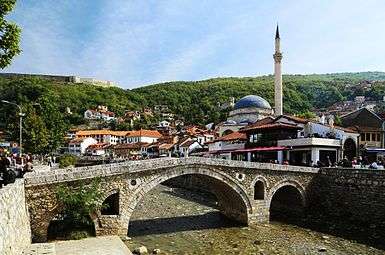
Stone Bridge,Prizren,Kosovo
-
Clock Tower,Prishtina
-
Mitrovica Mosque
-
.jpg)
Gracanica Monastery
-
Kosovo Museum, Prishtinë
-

Monument of Brotherhood and Unity in Pristina
-

Pristina martyr monument
-
Building of Public television of Kosovo
-

Hivzi Sulejmani Library
-
White Buildings
-
OSCE-Pristina
-
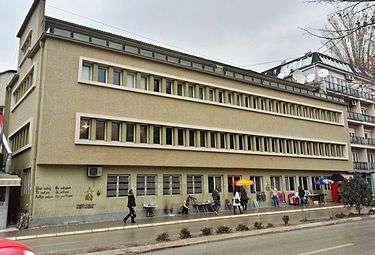
Faculty of Arts, music department, Pristina
-

Government Building
See also
- Islamic monuments in Kosovo
- Medieval Monuments in Kosovo
- Monuments of Kosovo
- Gračanica monastery
- Patriarchate of Peć (monastery)
- Cultural heritage of Kosovo
- Archaeology of Kosovo
References
- 1 2 3 Limani, Jeta. "Kulla of Mazrekaj family in Dranoc" (PDF).
- 1 2 3 4 5 "Prioritized Intervention List". Regional programme for cultural and natural heritage in south-east europe: 8. 23 January 2009. Retrieved 2 March 2014.
- 1 2 "Cultural Heritage in South-East: Kosovo". United Nations Educational, Scientific and Cultural Organization: 5. Retrieved 2 March 2014.
- ↑ Tawil, Edward. "Property rights in Kosovo: A haunting legacy of a society in transition.". International Center for Transitional Justice. Retrieved 2 March 2014.
- ↑ Kosova - Vështrim Monografik. Prishtinë: Akademia e Shkencave dhe e Arteve e Kosovës. p. 482.
- ↑ Kosova - Vështrim Monografik. Prishtinë: Akademia e Shkencave dhe e Arteve e Kosovës. p. 483.
- 1 2 Kosova - Vështrim Monografik. Prishtinë: Akademia e Shkencave dhe e Arteve e Kosovës. p. 484.
- ↑ "Ta shkatërrojmë të vjetrën, ta ndërtojmë të renë". Gazeta Express. Prishtinë. 2006-05-22.
- ↑ Prishtinë. Prishtina: National Council of the Municipalitz of Prishtina. 1959.
- ↑ Mullaademi, Leart (2009-08-22). "Union Hotel in Prishtina on fire". ONUP Magazine. Retrieved 2 March 2014.
- ↑ "The United Colors of Benetton megastore in Pristina opens. The historic Hotel Union, in the heart of the capital, is returned to the city following an important refurbishment and restoration". The United Colors of Benetton. Retrieved 2 March 2014.
- ↑ "HISTORIKU I NDËRTIMIT TË OBJEKTEVE TË QSHKSE "PALLATI I RINISË"". Pallati i Rinisë, Kulturës dhe Sporteve. Retrieved 2 March 2014.
- ↑ "PRISHTINË – mon amour : young artists reclaim Prishtina's space". Berlin Goes Balkan. Retrieved 2 March 2014.
- ↑ "Christ the Saviour Cathedral". inyourpocket. Archived from the original on 2 March 2014. Retrieved 2 March 2014.
- ↑ "Kosovo Mulls Fate of Milosevic-era Cathedral". Balkan Insight. Retrieved 2 March 2014.
- ↑ "Head of UN in Kosovo condemns attack on Serb cathedral in Pristina, appeals for end to violence". reliefweb. Retrieved 2 March 2014.
- 1 2 "Inaugurohet Katedralja "Nëna Terezë" në Prishtinë". Kosovo News Network. Retrieved 2 March 2014.
- ↑ "Kosovo's New Cathedral Stirs Muslim Resentment". BalkanInsight. Retrieved 2 March 2014.
- ↑ "Mother Teresa Cathedral". tripadvisor. Retrieved 2 March 2014.
- ↑ Doli, Flamur (2009). Arkitektura Vernakulare në Kosovë. Prishtinë: Association for the Preservation of Architectonic Heritage - SHRTA. pp. 93–97. ISBN 9789951878609.
External links
| Wikimedia Commons has media related to Architecture of Kosovo. |